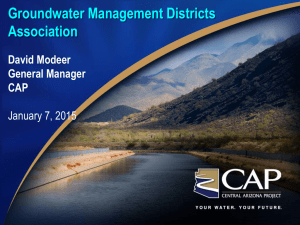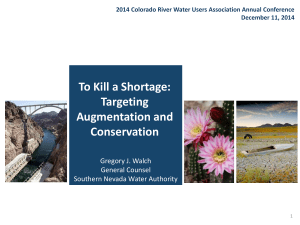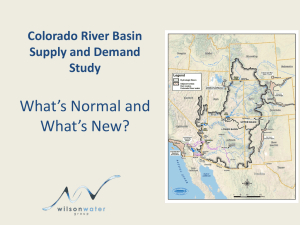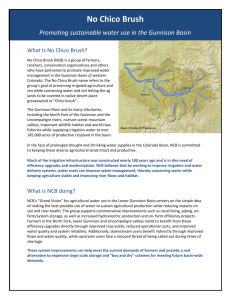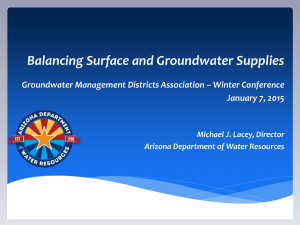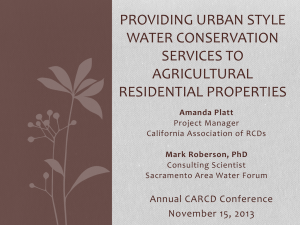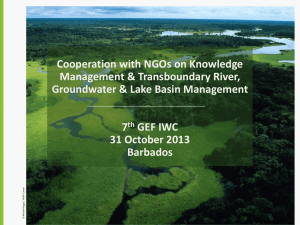Marie Pearthree - Urban Water Institute, Inc.
advertisement
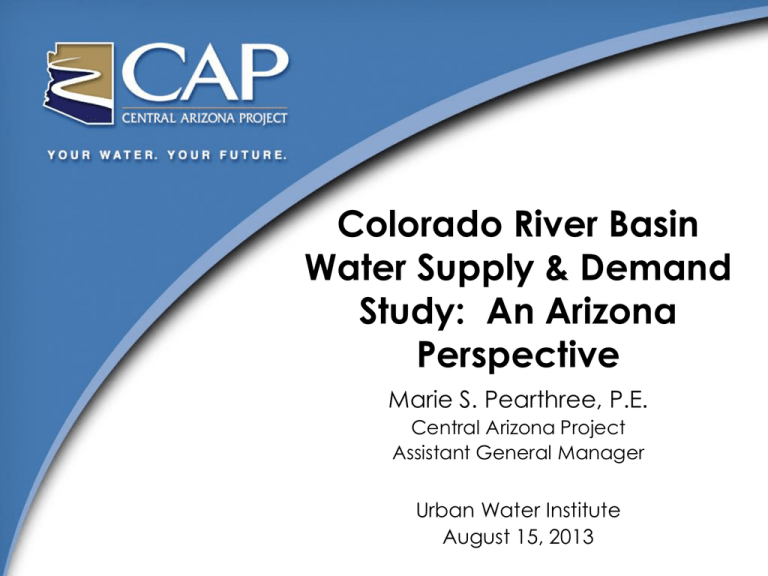
Colorado River Basin Water Supply & Demand Study: An Arizona Perspective Marie S. Pearthree, P.E. Central Arizona Project Assistant General Manager Urban Water Institute August 15, 2013 What is the Central Arizona Project? • 336-mile aqueduct brings Colorado River water from Lake Havasu to Tucson • 14 pumping plants lift water nearly 3000 feet • 11 underground pipelines • Lake Pleasant/New Waddell Dam • Delivers 1.6 million acre-feet of Colorado River water annually • Federal Reclamation Project operated and maintained by CAWCD • Single largest provider of Colorado River water to municipal and Native American users in the Basin Who Gets CAP Water (~1.6 MAF)? Cities – For residential, commercial and other customers Tribes – For on-reservation use, off- reservation storage, leases and other purposes (46% of CAP Supply) Farms – For irrigation of crops Recharge Projects – For annual and long-term storage Why the Central Arizona Project is So Active • CAP is the largest single Colorado River User within the boundaries of the watershed. • CAP has junior rights • CAP delivers to 80% (5.3 million) of Arizona’s population (approx. 1.6 MAF/yr) • CAP is critical to preventing groundwater overdraft and supports statewide recharge and replenishment functions Preparing for Shortages & Imbalances Planning • Research Activities ‒ Climate Change • Feasibility Studies ‒ Basin Study • Water Consv. Technology ‒ Desal, Ag, M&I Adaptation • Augmentation ‒ Weather Modification ‒ Desalination • System Efficiency ‒ Brock Reservoir ‒ Minute 319 (Binational Agreement) ‒ Vegetation Management ‒ Arizona Water Banking ‒ Recharge Projects • Reduce Demands ‒ Continue conservation Shortage Sharing: Impacts to CAP Augmentation Needs • 1975 Study finds “natural supply” insufficient for growing demands unless Basin States were willing “to accept the limitation in water supply and pattern the economic and social future of the basin to that limitation.” Same study determined the only option to address future water needs is “to augment the flows of the Colorado River thus increasing its water supply and permitting continued growth of water dependent developments.” --Westside Study Report on Critical Water Problems Facing the Eleven Western States (U.S. Dept. of the Interior, April 1975) Augmentation Needs • Post 1975, BOR identified several augmentation options and proposals but none initiated • All seven Basin States renewed investigation of augmentation and feasible options, publishing a report in 2008 --Study of Long-Term Augmentation Options for the Water Supply of the Colorado River System (Seven Basin States, March 2008) • All four portfolios evaluated in 2012 Basin Study included augmentation components. Summary Basin Study – Options & Strategies • Augmentation – – – – – River imports Desalination Wx Mod/Watershed Management Non-tributary groundwater Recycling • Reduce Demands (Conservation) • Modify Operations – M&I conservation – Ag conservation – Energy production conservation (drycooling) – Evaporation reduction (covers) – Reservoir management – Water Banking – Ag-Urban transfers Water Importation Options • Replace Colorado River water to the Front Range with Mississippi or Missouri River water • Potential to address water issues at a regional and national scale • Long-term project but with opposition • Mississippi Annual Discharge ~ 425 maf • Colorado River Annual Supply ~ 15 maf Basin Study - Desalination Options • Binational desalination projects with Mexico • Southern California Exchange • Yuma Area Brackish Water – Operating the Yuma Desalting Plant or alternatives • Salton Sea Brackish Water Irrigation Drainage Water Sonora Desal Concept NOT An Alternative! Basin Study-Conservation and Reuse Options • No specific programs identified in the study – Central Arizona (AMAs)and Las Vegas lead the nation in municipal and industrial water conservation – Arizona leads the nation in irrigation efficiency – CAP and Arizona stakeholders continuing investments • Need to identify new programs and how to fund them – water conservation is not “free” Basin Study-A Call to Action: • Significant imbalances by 2060 • Potential for critical imbalances begin as early as 2025. • Imbalances are driven by climate change/prolonged droughts plus increasing demands. • Augmentation projects, increased conservation, and reuse can resolve the “average” imbalances – protecting the Colorado River and its users. • Implementation of large-scale projects and programs will take a more than a decade. • Efforts to develop augmentation, conservation and reuse programs and projects must begin now. Basin Study: Multi-faceted Call To Action • By implementing additional measures, projected future imbalances in supply and demand can be successfully managed • Multi-faceted approach required • Federal government must partner with states Questions? Marie S. Pearthree, P.E. 623-869-2111 mpearthree@cap-az.com
